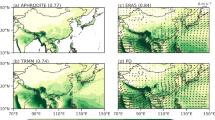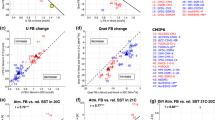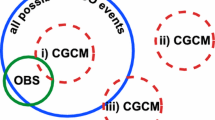Abstract
Idealized forcing experiments with 1% per year CO2 increase to stabilized doubled and quadrupled CO2, twenty-first century transient scenario experiments (SRES scenarios A1B and B1), and stabilized twenty-second century A1B and B1 experiments with two global coupled climate models (PCM and CCSM3) are analyzed for possible future changes of El Niño events. With increased CO2 in the models, there is a reduction of amplitude of El Niño events. This is particularly apparent with larger forcing in the stabilized 4×CO2 experiment in PCM and the stabilized greenhouse gas A1B experiment in CCSM3, where the reduction of amplitude is outside the range of the inherent multi-century variability of El Niño in the control runs of the models and is statistically significant. With moderately increased forcing (stabilized 2×CO2 in PCM and the stabilized B1 experiment in CCSM3), the reduction in amplitude is evident, but it is not significant. The change in El Niño behavior with larger forcing is attributed to the change in base state temperature in the equatorial Pacific, which is similar with increased greenhouse gases (GHGs) in both models. Positive temperature anomalies in and below the thermocline, associated with a reduction of the trade winds, and weakened Pacific Ocean subtropical cells, produce a less intense thermocline, and consequently lower amplitude El Niño events. The previously noted intensification of El Niño tropical precipitation anomalies in a warmer mean base state that applied when there was no appreciable change in El Niño amplitude does not hold in the present study where the El Niño events decrease in magnitude in a future warmer climate. North American surface temperature anomalies associated with El Niño are reduced and become less significant in the future events, with the anomalously deepened Aleutian low in the North Pacific weakened and moved eastward with greater radiative forcing. Part of this is attributed to the smaller amplitude events and thus lower amplitude teleconnections as indicated by contrasting composites of medium and high amplitude El Niño events from the control runs. The change in midlatitude base state circulation also contributes to the change in El Niño teleconnections. The effects of this change in base state on the weakened El Niño teleconnections over North America are confirmed in sensitivity experiments with a version of the atmospheric model in which heating anomalies are specified to mimic El Niño events in a base state changed due to increased GHGs.












Similar content being viewed by others
References
Achutarao K, Sperber K (2006) ENSO simulation in coupled ocean-atmosphere models: are the current models better? Clim Dyn (in press)
Ammann C, Meehl GA, Washington WM, Zender C (2003) A monthly and latitudinally varying volcanic forcing dataset in simulations of twentieth century climate. Geophys Res Lett 30 (12):1657, doi:10.1029/2003GL016875RR
Arblaster JM, Meehl GA (2006) Contribution of various external forcings to trends in the Southern Annular Mode. J Clim (in press)
Arblaster JM, Meehl GA, Moore A (2002) Interdecadal modulation of Australian rainfall. Clim Dyn 18:519–531
Branstator G (1983) Horizontal energy propagation in a barotropic atmosphere with meridional and zonal structure. J Atmos Sci 40:1689–1708
Branstator G (2002) Circumglobal teleconnections, the jet stream waveguide, and the North Atlantic oscillation. J Clim 15:1893–1910
Branstator G, Haupt S (1998) An empirical model of barotropic atmospheric dynamics and its response to tropical forcing. J Clim 11:2645–2667
Capotondi A et al (2006) Spatial and temporal structure of ENSO in 20th century coupled simulations. Ocean Model (in press)
Chen X, Kimoto M, Takahashi M (2005) Changes in ENSO in response to greenhouse warming as simulated by the CCSR/NIES/FRCGC coupled GCM. SOLA 1:149–152
Collins M (2000a) Understanding uncertainties in the response of ENSO to greenhouse warming. Geophys Res Lett 27:3509–3513
Collins M (2000b) The El Niño Southern Oscillation in the second Hadley centre coupled model and its response to greenhouse warming. J Clim 13:1299–1312
Collins WD et al (2006) The community climate system model: CCSM3. J. Clim (in press)
Cubasch U, Meehl GA, Boer GJ, Stouffer RJ, Dix M, Noda A, Senior CA, Raper S, Yap KS (2001) Projections of future climate change. In: Houghton JT., Ding Y, Griggs DJ, Noguer M, van der Linden P, Dai X, Maskell K, Johnson CI (eds) Climate change 2001: the scientific basis. Contribution of working group I to the 3rd assessment report of the intergovernmental panel on climate change, Cambridge University Press, Cambridge, pp 525–582
Dai A, Meehl GA, Washington WM,Wigley TML (2001) Ensemble simulations of 21st century climate changes: Business as usual vs. CO2 stabilization. Bull Am Meteorol Soc 82:2377–2388
Dai A, Hu A, Meehl GA, Washington WM, Strand WG (2005) Atlantic thermohaline circulation in a coupled general circulation model: unforced variations vs. forced changes. J Clim 18:3270–3293
Deser C, Capotondi A, Saravanan R, Phillips A (2006) Tropical Pacific and Atlantic climate variability in CCSM3. J Clim (in press)
Dickinson RE, Oleson KW, Bonan GB, Hoffman F, Thornton P, Vertenstein M, Yang Z-L, Zeng X (2006) The community land model and its climate statistics as a component of the community climate system model. J Clim (in press)
Guilyardi E et al (2004) Representing El Niño in coupled ocean-atmosphere GCMs: the dominant role of the atmospheric component. J Clim 17:4623–4629
Guilyardi E (2005) El Niño-mean state-seasonal cycle interactions in a multi-model ensemble. Clim Dyn DOI 10.1007/s00382-005-0084-6
Holland MM, Bitz CM, Hunke EC, Lipscomb WH, Schramm JL (2006) Influence of the sea ice thickness distribution on polar climate in CCSM3. J Clim (in press)
Hoskins BJ, Simmons AJ, Andrews DC (1977) Energy dispersion in a barotropic atmosphere. Quart J Roy Meteor Soc 103:553–567
Joseph R, Nigam S (2006) ENSO evolution and teleconnections in IPCC 20th century climate simulations: Realistic representation? J Clim (in press)
Kaplan A, Kushnir Y, Cane MA, Blumenthal MB (1997) Reduced space optimal analysis for historical datasets: 136 years of Atlantic sea surface temperatures. J Geophys Res 102:27835–27860
Kleeman R, McCreary JP, Klinger BA (1999) A mechanism for the decadal variation of ENSO. Geophys Res Lett 26:1743–1747
Knutson TR, Manabe S (1998) Model assessment of decadal variability and trends in the tropical. Pacific Ocean J Clim 11:2273–2296
Latif M et al (2001) ENSIP: the El Niño simulation intercomparison project. Clim Dyn 18:255–276
van Loon H, Meehl GA, Milliff R (2003) The Southern Oscillation in the early 1990s. Geophys Res Lett 30:1478, doi:10.1029/2002GL016307
McPhaden MJ, Zhang D (2002) Slowdown of the meridional overturning circulation in the upper Pacific Ocean. Nature 415:603–608
Meehl GA (1987) The annual cycle and interannual variability in the tropical Pacific and Indian Ocean regions. Mon Weather Rev 115:27–50
Meehl GA, Arblaster JM (2003) Mechanisms of projected future changes in south Asian monsoon precipitation. Clim Dyn 21:659–675
Meehl GA, Branstator GW, Washington WM (1993) Tropical Pacific interannual variability and CO2 climate change. J Clim 6:42–63
Meehl GA, Gent P, Arblaster JM, Otto-Bliesner B, Brady E, Craig A (2001) Factors that affect amplitude of El Niño in global coupled climate models. Clim Dyn 17:515–526
Meehl GA, Washington WM, Wigley TML, Arblaster JM, Dai A (2003) Solar and greenhouse gas forcing and climate response in the 20th century. J Clim 16:426–444
Meehl GA, Washington WM, Ammann C, Arblaster JM, Wigley TML, Tebaldi C (2004a) Combinations of natural and anthropogenic forcings and 20th century climate. J Clim 17:3721–3727
Meehl GA, Washington WM, Ammann C, Arblaster JM, Wigley TML, Tebaldi C (2004b) Combinations of natural and anthropogenic forcings and 20th century climate. J Clim 17:3721–3727
Meehl GA, Washington WM, Collins WD, Arblaster JM, Hu A, Buja LE, Strand WG, Teng H (2005) How much more global warming and sea level rise? Science 307:1769–1772
Meehl GA, Washington WM, Santer BD, Collins WD, Arblaster JM, Hu A, Lawrence D, Teng H, Buja LE, Strand WG (2006) Climate change in the 20th and 21st centuries and climate change commitment in the CCSM3. J Clim (in press)
Merryfield W (2006) Changes to ENSO under CO2 doubling in the IPCC AR4 coupled climate models. J Clim (in press)
Nonaka M, Xie S-P, McCreary JP (2001) Decadal variations in the subtropical cells and equatorial Pacific SST. Geophys Res Lett 29:1116, doi: 10.1029/2001GL013676
van Oldenborgh G, Philip S, Collins M (2005) El Niño in a changing climate: A multi-model study. Ocean Sci Discuss 2:267–29
Ropelewski CE, Halpert MS (1987) Global and regional scale precipitation patterns associated with the El Niño/Southern Oscillation. Mon Weather Rev 115:1606–1626
Santer BD, Wehner MF, Wigley TML, Sausen R, Meehl GA, Taylor KE, Ammann C, Arblaster JM, Washington WM, Boyle JS, Bruggemann W (2003a) Contributions of anthropogenic and natural forcing to recent tropopause height changes. Science 301:479–483
Santer BD, Wigley TML, Meehl GA, Wehner MF, Mears C, Schabel M, Wentz FJ, Ammann C, Arblaster JM, Bettge T, WashingtonWM, Taylor KE, Boyle JS, Bruggemann W, Doutriaux C (2003b) Influence of satellite data uncertainties on the detection of externally-forced climate change. Science 300:1280–1284
Selten FM, Branstator GW, Dijkstra HA, Kliphuis M (2004) Tropical origins for recent and future Northern Hemisphere climate change. Geophys Res Lett 31:L21205, doi:10.1029/2004GL020739
Solomon A, McCreary Jr JP, Kleeman R, Klinger BA (2003) Interannual and decadal variability in an intermediate coupled model of the Pacific region. J Clim 16:383–405
Timmermann A (1999) Detecting the nonstationary response of ENSO to greenhouse warming. J Atmos Sci 56:2313–2325
Timmermann A, Oberhuber J, Bacher A, Esch M, Latif M, Roeckner E (1999) Increased El Niño frequency in a climate model forced by future greenhouse warming. Nature 398:694–696
Wallace JM, Gutzler DS (1981) Teleconnections in the geopotential height field during the Northern Hemisphere winter. Mon Weather Rev 109:784–812
Washington WM, Weatherly JW, Meehl GA, Semtner Jr AJ, Bettge TW, Craig AP, Strand Jr. WG, Arblaster JM, Wayland VB, James R, Zhang Y (2000) Parallel climate model (PCM) control and transient simulations. Clim. Dyn 16:755–774
Yasunari T (1991) ``The monsoon year”–a new concept of the climatic year in the tropics. Bull Am Meteorol. Soc 72:1331–1338
Acknowledgements
The authors acknowledge Robert Tomas and Aixue Hu for their valuable contributions to this analysis, and Mat Collins and Eric Guilyardi for constructive and useful reviews of the manuscript. This work was supported in part by the Office of Biological and Environmental Research, U.S. Department of Energy, as part of its Climate Change Prediction Program, and by the Weather and Climate Impact Assessment Initiative at the National Center for Atmospheric Research. The National Center for Atmospheric Research is sponsored by the National Science Foundation.
Author information
Authors and Affiliations
Corresponding author
Rights and permissions
About this article
Cite this article
Meehl, G.A., Teng, H. & Branstator, G. Future changes of El Niño in two global coupled climate models. Clim Dyn 26, 549–566 (2006). https://doi.org/10.1007/s00382-005-0098-0
Received:
Accepted:
Published:
Issue Date:
DOI: https://doi.org/10.1007/s00382-005-0098-0




